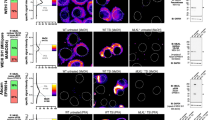Abstract
Necroptosis has been implicated as a critical cell death pathway in cancers, Alzheimer’s and other neurodegenerative diseases, and virus-infected cells. Necroptosis occurs when mixed-lineage kinase domain-like protein (MLKL) punctures the cytoplasmic membrane allowing a rapid influx of water leading to a loss of cellular integrity. As its role in human disease becomes apparent, methods identifying necroptosis will need to be further developed and optimized. Here we describe identification of necroptosis through quantifying cell death with pathway inhibitors and using western blots to identify end points of MLKL activation and protein-protein interactions leading to it.
Access this chapter
Tax calculation will be finalised at checkout
Purchases are for personal use only
Similar content being viewed by others
References
Holler N, Zaru R, Micheau O et al (2000) Fas triggers an alternative, caspase-8–independent cell death pathway using the kinase RIP as effector molecule. Nat Immunol 1:489–495. https://doi.org/10.1038/82732
Vercammen D, Beyaert R, Denecker G et al (1998) Inhibition of caspases increases the sensitivity of L929 cells to necrosis mediated by tumor necrosis factor. J Exp Med 187:1477–1485. https://doi.org/10.1084/jem.187.9.1477
Huang Z, Wu S-Q, Liang Y et al (2015) RIP1/RIP3 binding to HSV-1 ICP6 initiates necroptosis to restrict virus propagation in mice. Cell Host Microbe 17:229–242. https://doi.org/10.1016/j.chom.2015.01.002
Petrie EJ, Sandow JJ, Lehmann WIL et al (2019) Viral MLKL homologs subvert Necroptotic cell death by sequestering cellular RIPK3. Cell Rep 28:3309–3319.e5. https://doi.org/10.1016/j.celrep.2019.08.055
Zhang S, Tang M, Luo H et al (2017) Necroptosis in neurodegenerative diseases: a potential therapeutic target. Cell Death Dis 8:e2905–e2905. https://doi.org/10.1038/cddis.2017.286
Hanus J, Anderson C, Wang S (2015) RPE necroptosis in response to oxidative stress and in AMD. Ageing Res Rev 24:286–298. https://doi.org/10.1016/j.arr.2015.09.002
Bonnet MC, Preukschat D, Welz P-S et al (2011) The adaptor protein FADD protects epidermal keratinocytes from necroptosis in vivo and prevents skin inflammation. Immunity 35:572–582. https://doi.org/10.1016/j.immuni.2011.08.014
Moriwaki K, Bertin J, Gough PJ et al (2015) Differential roles of RIPK1 and RIPK3 in TNF-induced necroptosis and chemotherapeutic agent-induced cell death. Cell Death Dis 6:e1636–e1636. https://doi.org/10.1038/cddis.2015.16
Bozec D, Iuga AC, Roda G et al (2016) Critical function of the necroptosis adaptor RIPK3 in protecting from intestinal tumorigenesis. Oncotarget 7:46384–46400. https://doi.org/10.18632/oncotarget.10135
Oberst A, Dillon CP, Weinlich R et al (2011) Catalytic activity of the caspase-8-FLIPL complex inhibits RIPK3-dependent necrosis. Nature 471:363–367. https://doi.org/10.1038/nature09852
Wang H, Sun L, Su L et al (2014) Mixed lineage kinase domain-like protein MLKL causes necrotic membrane disruption upon phosphorylation by RIP3. Mol Cell 54:133–146. https://doi.org/10.1016/j.molcel.2014.03.003
Tanzer MC, Tripaydonis A, Webb AI et al (2015) Necroptosis signalling is tuned by phosphorylation of MLKL residues outside the pseudokinase domain activation loop. Biochem J 471:255–265. https://doi.org/10.1042/BJ20150678
Rodriguez DA, Weinlich R, Brown S et al (2016) Characterization of RIPK3-mediated phosphorylation of the activation loop of MLKL during necroptosis. Cell Death & Differ 23:76–88. https://doi.org/10.1038/cdd.2015.70
Najafov A, Mookhtiar AK, Luu HS et al (2019) TAM kinases promote necroptosis by regulating oligomerization of MLKL. Mol Cell 75:457–468.e4. https://doi.org/10.1016/j.molcel.2019.05.022
Dondelinger Y, Declercq W, Montessuit S et al (2014) MLKL compromises plasma membrane integrity by binding to phosphatidylinositol phosphates. Cell Rep 7:971–981. https://doi.org/10.1016/j.celrep.2014.04.026
Dovey CM, Diep J, Clarke BP et al (2018) MLKL requires the inositol phosphate code to execute necroptosis. Mol Cell 70:936–948.e7. https://doi.org/10.1016/j.molcel.2018.05.010
de Almagro MC, Goncharov T, Izrael-Tomasevic A et al (2017) Coordinated ubiquitination and phosphorylation of RIP1 regulates necroptotic cell death. Cell Death Different 24:26–37. https://doi.org/10.1038/cdd.2016.78
Kaiser WJ, Sridharan H, Huang C et al (2013) Toll-like receptor 3-mediated necrosis via TRIF, RIP3, and MLKL. J Biol Chem 288:31268–31279. https://doi.org/10.1074/jbc.M113.462341
Upton JW, Kaiser WJ, Mocarski ES (2012) DAI/ZBP1/DLM-1 complexes with RIP3 to mediate virus-induced programmed necrosis that is targeted by murine cytomegalovirus vIRA. Cell Host Microbe 11:290–297. https://doi.org/10.1016/j.chom.2012.01.016
Baker MODG, Shanmugam N, Pham CLL et al (2020) RHIM-based protein:protein interactions in microbial defence against programmed cell death by necroptosis. Semin Cell Dev Biol 99:86–95. https://doi.org/10.1016/j.semcdb.2018.05.004
Jang T, Zheng C, Li J et al (2014) Structural study of the RIPoptosome core reveals a helical assembly for kinase recruitment. Biochemistry 53:5424–5431. https://doi.org/10.1021/bi500585u
Acknowledgments
We would like to thank Nobuko Fukushima and James Bonner for technical assistance and Dr. Heather Koehler and Dr. Edward Mocarski for sharing expertise in necroptosis through consultation and protocol optimization.
Author information
Authors and Affiliations
Corresponding author
Editor information
Editors and Affiliations
Rights and permissions
Copyright information
© 2021 Springer Science+Business Media, LLC, part of Springer Nature
About this protocol
Cite this protocol
Cotsmire, S.M., Szczerba, M., Jacobs, B.L. (2021). Detecting Necroptosis in Virus-Infected Cells. In: Lucas, A.R. (eds) Viruses as Therapeutics. Methods in Molecular Biology, vol 2225. Humana, New York, NY. https://doi.org/10.1007/978-1-0716-1012-1_11
Download citation
DOI: https://doi.org/10.1007/978-1-0716-1012-1_11
Published:
Publisher Name: Humana, New York, NY
Print ISBN: 978-1-0716-1011-4
Online ISBN: 978-1-0716-1012-1
eBook Packages: Springer Protocols




